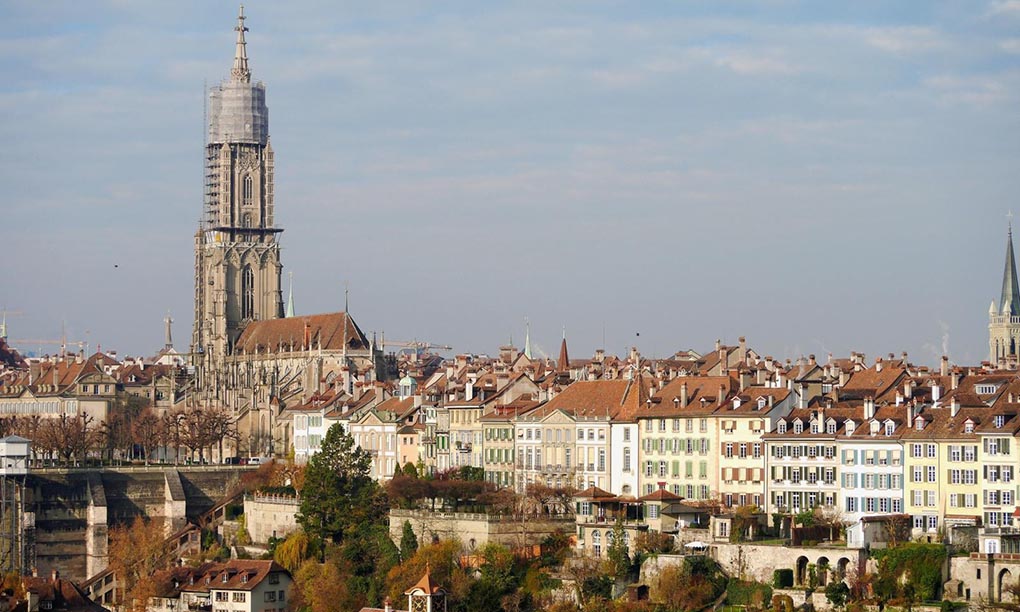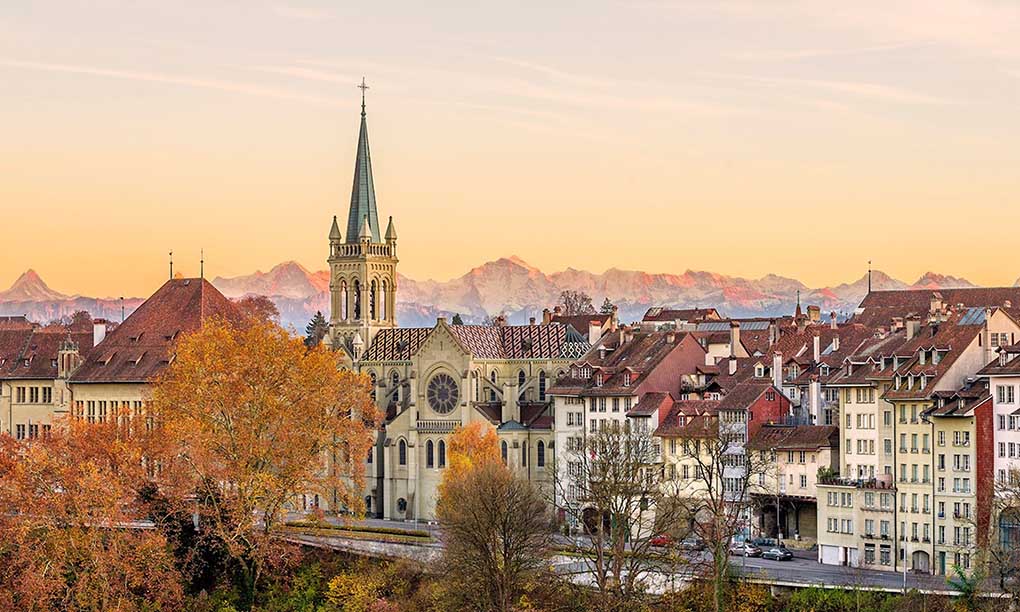On a crisp autumn morning in Switzerland, I wandered into the Rosengarten in Bern. Standing atop the hill, the entire Old Town unfurled beneath me like a silent, flowing canvas. Soft golden sunlight filtered through thin morning mist and fell upon the reddish-brown rooftops. In the distance, the Aare River wound its way through the city like a silk ribbon. In that moment, I realized that overlooking this city was not only a visual wonder—it touched something deep within my heart.
1. First Impressions of the Rosengarten: Autumn’s Quiet Elegance
The Rosengarten lies not far from Bern’s Old Town center. I climbed the stone steps at a leisurely pace, passing through dappled groves touched by autumn’s golden palette, until arriving at this tranquil hilltop. Though most roses had faded with the season, a few hardy blooms still quietly flourished in the cool autumn breeze, their colors softened but resilient. A carpet of golden leaves covered the lawn like nature’s own tapestry, and squirrels darted playfully around ancient tree trunks. Everything felt peaceful, serene, and warmly inviting.
I found a bench beneath a gently swaying chestnut tree, sat down, and gazed absentmindedly at the view. Bern’s Old Town, with its orderly rooftops of red tile, soaring clock towers, and Gothic façades, glowed in the slanted morning light. The Aare River curved like a silver ribbon around the city’s base, its waters rippling quietly as if whispering age-old stories. Occasionally, a distant train rumbled softly across the valley, its sound briefly audible before being swallowed again by the city’s gentle silence.
2. Overlooking Bern: A Harmonious Blend of City and Nature
Bern is a city defined by balance, where human activity and natural rhythm coexist effortlessly. It doesn’t boast skyscrapers or monumental modernity; instead, it embraces an understated grace, allowing space to breathe. From the Rosengarten, the most striking feature was the soaring spire of Bern Cathedral, its Gothic silhouette rising like a needle of history, anchoring the city in its spiritual and architectural heritage.
The Aare River, circling the Old Town in a wide embrace, played both protector and poet—its shimmering surface a mirror for the golden trees that flanked its banks. In autumn, the scene turned almost dreamlike: amber leaves swirled in the breeze, ducks glided through the water like painted brushstrokes, and swans floated in elegant silence. Joggers passed by, couples strolled hand-in-hand, and dogs barked in the distance. It was a reminder that Bern’s charm lies not just in its landmarks, but in the quiet choreography of everyday life lived in sync with nature.
3. A Walk Through the Rosengarten: Diary of Strolling
The garden features not only beautifully arranged rose beds but also a serene Japanese garden, several expressive sculptures, and a cozy café enclosed in floor-to-ceiling glass windows. As I strolled along the winding gravel paths, the sound of fallen leaves crunching gently beneath my feet felt like nature’s soft percussion. The crisp autumn air was filled with the faint scent of earth and fading petals. Each rose, whether the soft ivory of the classic “White Munich” or the rich crimson of the dramatic “Royal Ruby,” bore the texture of passing time—slightly weathered, yet dignified in their seasonal retreat.
In a peaceful corner stood a bronze statue of Albert Einstein, gazing thoughtfully ahead. It’s a quiet tribute to his years in Bern, where he once worked at the patent office and developed revolutionary theories. The Rosengarten’s contemplative stillness, with its gentle views and rhythmic calm, felt like the perfect setting for a mind such as his. As I stood before the statue, I found myself imagining him slowly pacing these paths, notebook in hand, thoughts spinning with the wonders of time, space, and light. It was a humbling, almost surreal, connection to one of history’s greatest thinkers.

4. Café Moments: Windows to Time
In the Rosengarten’s café, I ordered a steaming cappuccino and a thick slice of classic Bern honey cake (Berner Honigkuchen), rich with spices and tradition. The warmth of the coffee cup between my hands, combined with the cake’s delicate sweetness, created a comforting pause in my day. Seated by the large window, the panoramic view of the Old Town stretched before me like a living painting. The café itself felt like a glass cocoon—light, quiet, and shielded from the crisp autumn breeze that rustled the golden leaves outside.
Beyond the glass, the park was alive in its own peaceful rhythm. A group of university students sat cross-legged on the grass, immersed in textbooks and quiet conversation. An elderly painter with a wide-brimmed hat perched on a stool, his brush moving slowly across canvas as he captured the rooftops in the afternoon light. Nearby, a little boy ran with fierce delight after a fluttering red kite that danced with the breeze. Inside, the café remained hushed—just the soft hum of a coffee machine, the occasional gentle clink of porcelain, and the low murmur of contented voices. I pulled out my travel journal and began writing, not just to record details, but to weave a memory. In that moment, the café became more than a place—it became a window into the soul of Bern.
5. A Path to the Old Town: Walking Through History
Descending from the Rosengarten, I followed a gently winding, tree-lined path that led toward the BärenPark and the Nydeggbrücke. Although the distance was short, the atmosphere changed gradually with every step—as though I were stepping deeper into the city’s centuries-old past. The old stone walls lining the path were overgrown with vibrant autumn vines in rich shades of crimson, deep forest green, and golden amber, weaving a stunning tapestry that fluttered slightly in the breeze. Fallen leaves rustled beneath my shoes, each step echoing softly through the quiet descent.
When I reached the BärenPark, I paused for a moment of reflection, watching a few brown bears lounging and foraging leisurely. Their calm demeanor added a sense of timelessness to the scene. These creatures aren’t just part of a modern animal enclosure—they are living emblems of Bern itself, their legacy deeply rooted in the city’s name and coat of arms. After a few minutes, I crossed the Nydeggbrücke, where the Aare River sparkled below. On the other side, I stepped into the soul of the Old Town. Arcaded walkways stretched out on either side, their graceful arches concealing a treasure trove of charming establishments—secondhand bookstores filled with yellowed pages, small galleries featuring local artists, antique watch shops with gleaming displays, and inviting cafés spilling the scent of roasted coffee into the crisp air. The architecture may have been ancient, but the spirit within it pulsed with warmth and vibrancy.

6. Wandering Bern’s Autumn Streets
In autumn, Bern’s streets seemed tinted with a soft filter. Leaves drifted in the breeze, passersby wore trench coats and scarves, and their footsteps carried a unhurried rhythm. In the Town Hall Plaza, a street performer played the accordion, melodies laced with nostalgia. At the Zytglogge clock tower, crowds gathered for the mechanical clock’s hourly show—though I’d seen it many times, each display still felt wondrously childlike.
I wandered along Kramgasse to Einstein’s former residence, stopping to savor hot cocoa from a century-old chocolate shop. Every store, though unassuming, exuded charm. Bern’s allure lies not in “tourist spots,” but in the richness and serenity of its slow pace.
7. Dusk at the Rosengarten: The City’s Farewell in Light and Shadow
As dusk approached, I returned to the Rosengarten. The sunlight had turned slanted, and the city began to be enveloped in a pale purple sky. The Old Town’s red roofs glowed warmly in the twilight; the river reflected the last light; distant hills faded into blue-gray.
On the viewing platform, I met a local grandfather who came here for evening strolls daily. He told me that each season reveals a different beauty in this garden, but autumn light was the gentlest and most moving. He pointed to the clock tower and said, “Look, the sun resting there—that is Bern’s serene pride.”
8. Leaving in the Night: Carrying a Bittersweet Memory
Night fell as I boarded the light rail home. Outside the window, the streetlights and river reflections shimmered slowly. Looking back, I felt deeply grateful. The Rosengarten isn’t a “thrilling attraction”—it requires no ticket, no queue, no grand staging. Yet it gave me the most profound travel experience.
Travel isn’t about seeing many sights—it’s about truly stopping to converse with a city. In the Rosengarten, I felt Bern’s heartbeat: slow, composed, and deeply flavorful. Morning sunrises, evening light, the scent of coffee, and the rustle of leaves—all these moments have quietly imprinted themselves in my heart as the most beautiful times of this journey.
If you visit Bern, take a moment to step into this quiet garden. Sit on a bench and quietly oversee the city. You’ll discover that beyond the sights is a gentle resonance, waiting for you to listen with your heart.
Tags: BärenPark, Berner Münster, Rosengarten